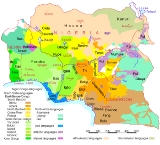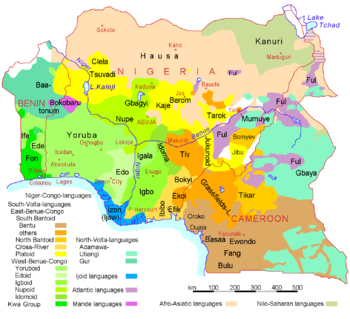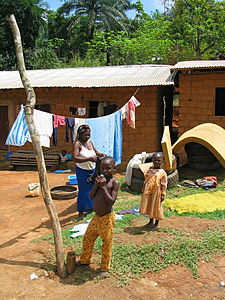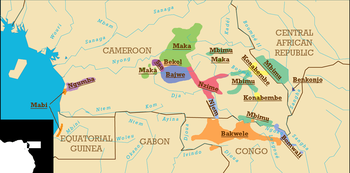
Demographics of Cameroon
Encyclopedia


Demographics
Demographics are the most recent statistical characteristics of a population. These types of data are used widely in sociology , public policy, and marketing. Commonly examined demographics include gender, race, age, disabilities, mobility, home ownership, employment status, and even location...
features of the population
Population
A population is all the organisms that both belong to the same group or species and live in the same geographical area. The area that is used to define a sexual population is such that inter-breeding is possible between any pair within the area and more probable than cross-breeding with individuals...
of Cameroon
Cameroon
Cameroon, officially the Republic of Cameroon , is a country in west Central Africa. It is bordered by Nigeria to the west; Chad to the northeast; the Central African Republic to the east; and Equatorial Guinea, Gabon, and the Republic of the Congo to the south. Cameroon's coastline lies on the...
, including population density
Population density
Population density is a measurement of population per unit area or unit volume. It is frequently applied to living organisms, and particularly to humans...
, ethnicity
Ethnic group
An ethnic group is a group of people whose members identify with each other, through a common heritage, often consisting of a common language, a common culture and/or an ideology that stresses common ancestry or endogamy...
, education level, health of the populace, economic status, religious affiliations and other aspects of the population.
The demographic profile of Cameroon is complex for a country of its population. Cameroon
Cameroon
Cameroon, officially the Republic of Cameroon , is a country in west Central Africa. It is bordered by Nigeria to the west; Chad to the northeast; the Central African Republic to the east; and Equatorial Guinea, Gabon, and the Republic of the Congo to the south. Cameroon's coastline lies on the...
comprises an estimated 250 distinct ethnic groups, which may be formed into five large regional-cultural divisions:
- western highlanders (Semi-Bantu or grassfielders), including the BamilekeBamilekeThe Bamileke is a folk whose native ancestral area is in the western highlands of Cameroon's West Province, west of the Noun River and southeast of the Bamboutos Mountains and in the Moungo region of the Littoral, Southwest, and Centre Provinces. They are a part of the Semi-Bantu ethnic groups...
, BamumBamum peopleThe Bamum, sometimes called Bamoum, Bamun, Bamoun, or Mum, are an ethnic group of Cameroon with around 215,000 members.-Religion:...
(or Bamoun), and many smaller TikarTikarThe Tikar are a group of related ethnic groups in Cameroon. They live primarily in the northwestern part of the country, in the Northwest Province near the Nigerian border. They speak Bantoid language, also called Tikar. Their population is approximately 25,000.The Tikar have elements of...
groups in the Northwest (est. 38% of total population); - coastal tropical forest peoples, including the Bassa, DualaDuala peopleThe Duala are an ethnic group of Cameroon. They primarily inhabit the littoral region to the coast and form a portion of the Sawa, or Cameroonian coastal peoples...
(or Douala), and many smaller groups in the Southwest (12%); - southern tropical forest peoples, including the Beti-PahuinBeti-PahuinThe Beti-Pahuin are a group of related peoples who inhabit the rain forest regions of Cameroon, Republic of the Congo, Equatorial Guinea, Gabon, and São Tomé and Príncipe. Though they separate themselves into several individual ethnic groups, they all share a common history and culture. They were...
, Bulu (a subgroup of Beti-Pahuin), Fang (subgroup of Beti-Pahuin), MakaMaka peopleThe Maka or Makaa are an ethnic group inhabiting the southern rain forest zone of Cameroon. They live primarily in the northern portions of the Upper Nyong division of Cameroon's East Province. Major Maka settlements include Abong-Mbang, Doumé, and Nguélémendouka...
, NjemNjemThe Njyem are an ethnic group inhabiting the rain forest zone of southern Cameroon and northern Republic of the Congo. In Cameroon, the Njyem live along the road running south from Lomié, passing the government center of Ngoyla and going as far south as Djadom. From there, footpaths extend to...
, and Baka pygmiesPygmyPygmy is a term used for various ethnic groups worldwide whose average height is unusually short; anthropologists define pygmy as any group whose adult men grow to less than 150 cm in average height. A member of a slightly taller group is termed "pygmoid." The best known pygmies are the Aka,...
(18%); - predominantly IslamIslamIslam . The most common are and . : Arabic pronunciation varies regionally. The first vowel ranges from ~~. The second vowel ranges from ~~~...
ic peoples of the northern semi-arid regions (the SahelSahelThe Sahel is the ecoclimatic and biogeographic zone of transition between the Sahara desert in the North and the Sudanian Savannas in the south.It stretches across the North African continent between the Atlantic Ocean and the Red Sea....
) and central highlands, including the FulaniFula peopleFula people or Fulani or Fulbe are an ethnic group spread over many countries, predominantly in West Africa, but found also in Central Africa and Sudanese North Africa...
(14%); and - the "KirdiKirdiThe Kirdi are is a term that describes some many cultures and ethnic groups who inhabit northwestern Cameroon and northeastern Nigeria.The term was applied to various peoples who had not converted to Islam at the time of colonization and was a pejorative, although some writers have reappropriated it...
", non-Islamic or recently Islamic peoples of the northern desert and central highlands (18%).
An up-to-date demographic profile is unavailable from the country's government, which hasn't published census data since 1976.
The Cameroon government held two national censuses during the country's first 44 years as an independent country, in 1976 and again in 1987. Results from the second head count were never published. A third census, expected to take years to product results, began on November 11, 2005, with a three-week interviewing phase. It is one of a series of projects and reforms required by the International Monetary Fund
International Monetary Fund
The International Monetary Fund is an organization of 187 countries, working to foster global monetary cooperation, secure financial stability, facilitate international trade, promote high employment and sustainable economic growth, and reduce poverty around the world...
as prerequisites for foreign debt relief
Debt relief
Debt relief is the partial or total forgiveness of debt, or the slowing or stopping of debt growth, owed by individuals, corporations, or nations. From antiquity through the 19th century, it refers to domestic debts, in particular agricultural debts and freeing of debt slaves...
.
CIA World Factbook demographic statistics


Population
- 19,294,149 (2010 est.)
- Note: estimates for this country explicitly take into account the effects of excess mortality due to AIDS; this can result in lower life expectancy, higher infant mortality and death rates, lower population and growth rates, and changes in the distribution of population by age and sex than would otherwise be expected (July 2009 est.)
Age structure
- 0-14 years: 40.9% (male 3,891,762/female 3,822,870)
- 15-64 years: 55.9% (male 5,298,143/female 5,250,493)
- 65 years and over: 3.3% (male 283,289/female 332,744) (2010 est.)
Urbanization
- Urban population: 57% of total population (2008)
- Rate of urbanization: 3.5% annual rate of change (2005-10 est.)
Sex ratio
- At birth: 1.03 male(s)/female
- Under 15 years: 1.02 male(s)/female
- 15-64 years: 1.01 male(s)/female
- 65 years and over: 0.85 male(s)/female
- Total population: 1.01 male(s)/female (2009 est.)
Infant mortality rate
- total: 62.15 deaths/1,000 live births
- male: 66.8 deaths/1,000 live births
- female: 57.36 deaths/1,000 live births (2010 est.)
Life expectancy at birth
- total population: 54.04 years
- male: 53.21 years
- female: 54.9 years (2010 est.)
HIV/AIDS
- Adult prevalence rate: 5.1% (2007 est.)
- People living with HIV/AIDS: 540,000 (2007 est.)
- Deaths: 39,000 (2007 est.)
Major infectious diseases
- Degree of risk: very high
- FoodFoodborne illnessFoodborne illness is any illness resulting from the consumption of contaminated food, pathogenic bacteria, viruses, or parasites that contaminate food, as well as chemical or natural toxins such as poisonous mushrooms.-Causes:Foodborne illness usually arises from improper handling, preparation, or...
or waterborne diseasesWaterborne diseasesWaterborne diseases are caused by pathogenic microorganisms which are directly transmitted when contaminated fresh water is consumed. Contaminated fresh water, used in the preparation of food, can be the source of foodborne disease through consumption of the same microorganisms...
: bacterial and protozoal diarrhea, hepatitis AHepatitis AHepatitis A is an acute infectious disease of the liver caused by the hepatitis A virus , an RNA virus, usually spread the fecal-oral route; transmitted person-to-person by ingestion of contaminated food or water or through direct contact with an infectious person...
and hepatitis EHepatitis EHepatitis E is a viral hepatitis caused by infection with a virus called hepatitis E virus . HEV is a positive-sense single-stranded RNA icosahedral virus with a 7.5 kilobase genome. HEV has a fecal-oral transmission route. It is one of five known hepatitis viruses: A, B, C, D, and E...
, and typhoid feverTyphoid feverTyphoid fever, also known as Typhoid, is a common worldwide bacterial disease, transmitted by the ingestion of food or water contaminated with the feces of an infected person, which contain the bacterium Salmonella enterica, serovar Typhi... - Vectorborne diseases: malariaMalariaMalaria is a mosquito-borne infectious disease of humans and other animals caused by eukaryotic protists of the genus Plasmodium. The disease results from the multiplication of Plasmodium parasites within red blood cells, causing symptoms that typically include fever and headache, in severe cases...
and yellow feverYellow feverYellow fever is an acute viral hemorrhagic disease. The virus is a 40 to 50 nm enveloped RNA virus with positive sense of the Flaviviridae family.... - Water contact disease: schistosomiasisSchistosomiasisSchistosomiasis is a parasitic disease caused by several species of trematodes , a parasitic worm of the genus Schistosoma. Snails often act as an intermediary agent for the infectious diseases until a new human host is found...
- Respiratory diseaseRespiratory diseaseRespiratory disease is a medical term that encompasses pathological conditions affecting the organs and tissues that make gas exchange possible in higher organisms, and includes conditions of the upper respiratory tract, trachea, bronchi, bronchioles, alveoli, pleura and pleural cavity, and the...
: meningococcal meningitis - Animal contact disease: rabiesRabiesRabies is a viral disease that causes acute encephalitis in warm-blooded animals. It is zoonotic , most commonly by a bite from an infected animal. For a human, rabies is almost invariably fatal if post-exposure prophylaxis is not administered prior to the onset of severe symptoms...
(2009)
Ethnic groups
- Cameroon Highlanders 31%
- Equatorial Bantu 19%
- KirdiKirdiThe Kirdi are is a term that describes some many cultures and ethnic groups who inhabit northwestern Cameroon and northeastern Nigeria.The term was applied to various peoples who had not converted to Islam at the time of colonization and was a pejorative, although some writers have reappropriated it...
11% - Fulani 10%
- Northwestern Bantu 8%
- Eastern Nigritic 7%
- other African 13%
- non-African less than 1%
Religions
Indigenous beliefs 40%, Christian 40%, Muslim 20%-
- See also Bahá'í Faith in CameroonBahá'í Faith in CameroonThe Bahá'í Faith in Cameroon was established when the country was separated into two colonies - British and French Cameroon. The first Bahá'í in Cameroon was Enoch Olinga, who had left his homeland of Uganda to bring the religion to British Cameroon in 1953...
, BwitiBwitiBwiti is a West Central African spiritual practice by the forest-dwelling Babongo and Mitsogo people of Gabon, where it is counted as one of the three official religions, and the Fang people of Gabon and Cameroon...
, Islam in CameroonIslam in CameroonMuslims comprise roughly 24 percent of the 21 million inhabitants in the African country of Cameroon. The Fulani, a pastoral nomadic group, spread Islam in early 19th century West Africa largely through commercial activity and Sufi brotherhoods . In the northern provinces, the locally dominant...
, JenguJenguA jengu is a water spirit and deity in the traditional beliefs of the Sawa ethnic groups of Cameroon, particularly the Duala, Bakweri, and related Sawa peoples. Among the Bakweri, the name is liengu...
, and Roman Catholicism in CameroonRoman Catholicism in CameroonThe Catholic Church in Cameroon is part of the worldwide Roman Catholic Church, under the spiritual leadership of the Pope and curia in Rome.There are an estimated 4.25 million baptised Catholics in the Republic of Cameroon, 26% of the population, in 24 Dioceses...
.
- See also Bahá'í Faith in Cameroon
Languages
There are 24 major African language groups in Cameroon; additionally, EnglishEnglish language
English is a West Germanic language that arose in the Anglo-Saxon kingdoms of England and spread into what was to become south-east Scotland under the influence of the Anglian medieval kingdom of Northumbria...
and French
French language
French is a Romance language spoken as a first language in France, the Romandy region in Switzerland, Wallonia and Brussels in Belgium, Monaco, the regions of Quebec and Acadia in Canada, and by various communities elsewhere. Second-language speakers of French are distributed throughout many parts...
are official languages. Cameroonian Pidgin English
Cameroonian Pidgin English
Cameroonian Pidgin English, or Cameroonian Creole, is a language variety of Cameroon. It is also known as Kamtok . Five varieties are currently recognised:...
is also widely spoken.
Peoples concentrated in the Southwest and Northwest Provinces — around Buea
Buea
Buea is the capital of the Southwest Region of Cameroon. The town is located on the eastern slopes of Mount Cameroon and has a population of 90,088 . Buea was the colonial capital of the German Kamerun from 1901 to 1919,and the capital of the Southern Cameroons from 1949 until 1961...
and Bamenda
Bamenda
Bamenda, also known as Abakwa and Mankon Town, is a city in northwestern Cameroon and capital of the North West Province. The city had a population of 269,530 at the 2005 Census, and is located 366 km north-west of the Cameroonian capital, Yaoundé...
— use standard English
English language
English is a West Germanic language that arose in the Anglo-Saxon kingdoms of England and spread into what was to become south-east Scotland under the influence of the Anglian medieval kingdom of Northumbria...
and Cameroonian Pidgin English
Cameroonian Pidgin English
Cameroonian Pidgin English, or Cameroonian Creole, is a language variety of Cameroon. It is also known as Kamtok . Five varieties are currently recognised:...
, as well as their local languages. In the three northern provinces — Adamawa
Adamawa Province
The Adamawa Region is a constituent region of the Republic of Cameroon. It borders the Centre and East regions to the south, the Northwest and West regions to the southwest, Nigeria to the west, the Central African Republic to the east, and the North Region to the north.This mountainous area...
, North, and Far North
Far North Province
The Far North Region , also known as the Extreme North Region , is the northernmost constituent province of the Republic of Cameroon. It borders the North Region to the south, Chad to the east, and Nigeria to the west. The capital is Maroua.The province is one of Cameroon's most culturally diverse...
— either French
French language
French is a Romance language spoken as a first language in France, the Romandy region in Switzerland, Wallonia and Brussels in Belgium, Monaco, the regions of Quebec and Acadia in Canada, and by various communities elsewhere. Second-language speakers of French are distributed throughout many parts...
or Fulfulde
Fula language
The Fula or Fulani language is a language of West Africa. It is spoken as a first language by the and related groups from Senegambia and Guinea to Cameroon and Sudan...
(the language of the Fulani
Fula people
Fula people or Fulani or Fulbe are an ethnic group spread over many countries, predominantly in West Africa, but found also in Central Africa and Sudanese North Africa...
) is widely spoken. Elsewhere, French is the principal second language, although pidgin and some local languages such as Ewondo
Ewondo language
Ewondo is the language of the Ewondo people of Cameroon. The language had 577,700 native speakers in 1982. Ewondo is a trade language. Dialects include Badjia , Bafeuk, Bamvele , Bane, Beti, Enoah, Evouzok, Fong, Mbida-Bani, Mvete, Mvog-Niengue, Omvang, Yabekolo , Yabeka, and Yabekanga...
, the dialect of a Beti clan from the Yaoundé
Yaoundé
-Transportation:Yaoundé Nsimalen International Airport is a major civilian hub, while nearby Yaoundé Airport is used by the military. Railway lines run west to the port city of Douala and north to N'Gaoundéré. Many bus companies operate from the city; particularly in the Nsam and Mvan neighborhoods...
area, have a wide currency.
Indigenous languages of Cameroon include:
- BasaaBasaa languageBasaa is a Bantu language spoken in Cameroon. It is spoken by about 230,000 people in Centre and Littoral provinces.-Vowels:-Consonants:...
- BikyaBikya languageBikya is a Bantoid language isolate spoken in Cameroon. It is unknown if this language is still existent. In 1986 four surviving speakers were identified, although only one spoke the language fluently....
- BungBung languageThe Bung language is a nearly extinct language of Cameroon spoken by 3 people at the village of Boung on the Adamawa Plateau. A wordlist collected for it shows its strongest resemblance to be with the Ndung dialect of Mambiloid language Kwanja, although that may simply be because this has become...
- KanuriKanuri languageKanuri is a dialect continuum spoken by some four million people, as of 1987, in Nigeria, Niger, Chad and Cameroon, as well as small minorities in southern Libya and by a diaspora in Sudan. It belongs to the Western Saharan subphylum of Nilo-Saharan...
- Ngumba
- YeniYeni languageThe Yeni language is an extinct language of Cameroon, formerly spoken around Djeni Mountain in the Nyalang area. All that remains of the language, apparently, is a song remembered by some Sandani speakers...
- BamumBamum languageBamum , or in its French spelling Bamoun, is one of the Benue–Congo languages of Cameroon, with approximately a quarter million speakers. The language is well-known for its original script developed by King Njoya and his palace circle around 1895...
Literacy
- Definition: age 15 and over can read and write
- Total population: 67.9% (2004 est.; source: UNDP 2006; NB- this figure is given without reference to which languages are considered)
- Male: 77.0%
- Female: 59.8%

